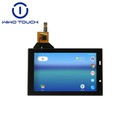Touch screens are a type of overlay placed on a display screen used to register touch interaction on the screen. Touch screens are not a type of display, but rather a component that can be added to an existing screen. Touch screens use two different methods to register touch interaction called "resistive" and "capacitive," which refer to pressure and touch sensitivity respectively. Resistive screens work by measuring voltage differences caused by finger or stylus pressure on the screen, whereas capacitive screens work by measuring current interruption.

TFT touch screens use both the TFT and touch screen technologies together to create a touch-based interface overlay on a thin, lightweight display. Touch screens were in use before TFT LCD dominated the large display market and formerly existed as overlays for CRT screens. However, CRT screens require a much larger footprint and weigh several times more for the same screen space as LCD screens. Combining touch screens with TFT displays helped make the concept practical and affordable.




